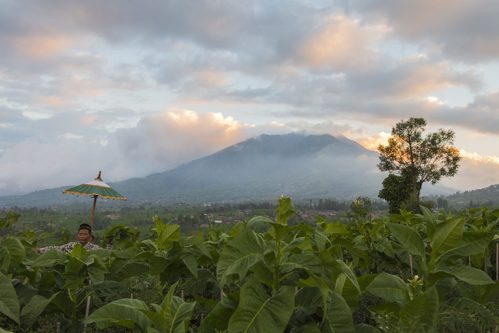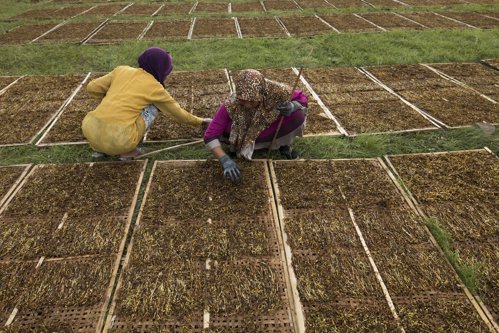
Myth
Tobacco growing is bad for growers’ health

Tobacco grows on 0.25% of the world cultivated land so the size of its production by itself it is not a threat compared to many other agricultural activities. Even in the countries where tobacco is a very important crop, with the exception of two cases, it covers far less than 1% of the cultivated land. Soil degradation destroys the livelihood of growers. The fear of soil degradation is more than adequate incentive for tobacco growers to employ the right techniques, especially rotation with other crops, to avoid damage to the land, which is the main asset of small-scale farmers. In fact, as tobacco is a particularly tough crop that can be grown in harsh conditions, the need for significant amounts of fertilizers is actually reduced compared to other crops. This is also proved by several comparative reports carried out by the FAO. Please check them in our library. Plant protection product (pesticide) use on tobacco is comparable to that of other crops. This is clear from the rates of use on the labels of plant protection products, which are checked by regulatory authorities around the world. Please check our library. Tobacco is particularly resistant to drought. In the overwhelming majority of cases tobacco is rain-fed. On small-holder farms it is always rain-fed. Irrigated tobacco probably is no more than 15% of world production. Even in the case where wood is used as fuel for curing tobacco, in those countries our farmers have considerable tree and bamboo planting schemes to ensure wood is sourced from sustainable sources and does not lead to deforestation. In many countries where burley tobacco is grown, farmers adopt live bars, where the pillars of the barn are the trunks of live trees which are purposely planted at appropriate distance.
Myth
Tobacco growing is bad for growers’ health

Fact
The only health risk that is unique to tobacco crops is green tobacco sickness, a condition caused by handling wet tobacco leaves in conditions of high temperatures. Though there are no precise statistics, from literature reports it seems to affect more less than 1% of people working in tobacco farms. It can be avoided through basic measures like ensuring that skin is covered with long clothing or gloves before handling leaves or changing wet clothing after harvesting. The risk posed by green tobacco sickness can be minimized through education. Our members are working at national level with public bodies and the tobacco industry to ensure that awareness for farmers and workers is as high as possible. Plant protection products (pesticides) are highly regulated substances that are authorized on the basis of a governmental assessment that includes an analysis of health and environmental risks. Plant protection products used in tobacco are also used in the cultivation of other crops and at a rate which is no higher, and in some cases lower, because of the toughness of the tobacco plant. Pant protection products are medicaments for plants, and like the medicaments for plants they must be handled with care. Our members are trained on the safe handling, use, storage and disposal of plant protection products.
Myth
Tobacco growing exacerbates poverty and contractual arrangements trap farmers in a vicious cycle of debt

Fact
Tobacco is a cash crop and the chief incentive for tobacco growing is that it is more profitable than most other crops. This is acknowledged in all relevant independent literature on the topic, including in many studies commissioned by the WHO. We do not consider independent authors those who belong to tobacco control organizations and are paid to speak negatively of tobacco in all its forms, including leaf production. Smallholder farmers may be small, but still have a choice. If they realized that they regularly lost out of tobacco, they would not continue to grow it just out of habit, but would quickly switch to something else more profitable. Contracts are not forced on tobacco farmers but are voluntarily signed. Contracts are also universally recognized as the best way to address the price fluctuations which can take place when selling on the open market without a contract. Tobacco growers make a contract with a buyer, stating that crop of certain quantity and quality will be delivered at a pre-determined price. Buying companies help farmers with selection of variety, seed and other input supply, dissemination of good cultivation practices etc. Their field staff undertake regular inspection of the fields, and recommend measures to improve quality of the product, and third parties like research institutes and agricultural universities are also involved to train the farmers. At the end of season, the dried leaf is taken to the close-by market centres and sod at the previously agreed price. This has resulted in improved productivity and assured market for tobacco growers, and also saves them from the trouble of having to transport on long distances, store and market their produce. In countries where there are auctions system or there is a prevalent free market outside contract, tobacco growers are free to choose which alternative they prefer, whether to sell under contract or sell without one.
Myth
Child labour is a particular problem in tobacco growing

Fact
Child labour is a problem in agricultural sectors across the developing world, a fact which is recognised by the International Labour Organization, trade unions, employers associations and national governments: the Government of the United States every two years publishes a list of goods produced with child labour. The list comprises 148 goods from 76 countries, of which 75 are agricultural products. However, tobacco growers believe that they should play their part along with other relevant stakeholders in tackling a complex issue. For this reason, in 2001 ITGA was one of the three founders and has always been a Board member of the Eliminating Child Labour in Tobacco-Growing Foundation (ECLT), a partnership between tobacco growers, leaf suppliers, tobacco manufacturers and the unions to tackle child labour. The International Labour Organization acts as adviser to the ECLT. Since its creation in 2001, the ECLT has funded and co-managed projects for the reduction and elimination of child labour in Malawi, Mozambique, Tanzania, Uganda, Zambia, Kyrgyzstan, Indonesia, Philippines and Guatemala and is doing some work with the Government of Zimbabwe. In addition to this initiative which is managed centrally by the ITGA Secretariat, our members carry out a number of initiatives to ensure tobacco growing communities are aware of the importance of not involving children in farm work in order to progressively eradicate child labour.
Myth
Tobacco growing aggravates food security

Fact
There is no evidence to support this assertion. Tobacco covers only 0.25% of cultivated land, excluding pastures. Even in countries where tobacco is the major crop, with the exception of two cases, where however it does not reach 3% of cultivated land, it never exceeds 1% of the cultivated land. In such a context, at macro-level tobacco production cannot be considered a threat to food security. At micro-level, in the overwhelming majority of cases, tobacco is grown by small-scale farmers who use only a fraction of their farm for tobacco: they plant other crops, including food crops, in rotation with tobacco and to complement tobacco production. Rather than threatening food security in impoverished regions of the world, where tobacco is grown it is safeguarding food security. Tobacco growers, thanks to the rotational crops they grow as part of good agricultural practices, also grow food crops which guarantee food for the family. The cash from tobacco allows to purchase something else.
Myth
There are many economically sustainable alternatives to tobacco farming for small-scale farmers, even in low- and middle-income countries.

Fact
Tobacco generally grows well on marginal soils where other crops do not grow well. If economically sustainable alternative crops were available to millions of farmers, certainly many more farmers would have adopted them. Those who decide to switch to another crop do it because they have found an alternative, but those who remain is because they find an advantage in tobacco growing. Tobacco is grown increasingly in areas where a) either farms are too small to allow other field crops which are paid much less than tobacco b) or where there is no cold chain or primary processing industry available to allow the production of crops which need immediate processing to be put on the market. All tobacco growers grow tobacco in rotation with other crops, but in the overwhelming majority of cases the income from tobacco is much higher than the income from the other farm activities. Unless a country develops alternative markets, farmers will always grow what they perceive is the best solution for them, for the size of their farm, for their soil type, water availability and weather conditions, and for the infrastructure to preserve the goods till delivery to the buyer. We do not deny that there are alternatives, but certainly there are no alternatives available to all tobacco growers. Tobacco growers who have no alternatives cannot bear the burden to have their livelihood removed by legislation unless their governments provide practical and tangible support to help in the transition. So far we have not seen much help.